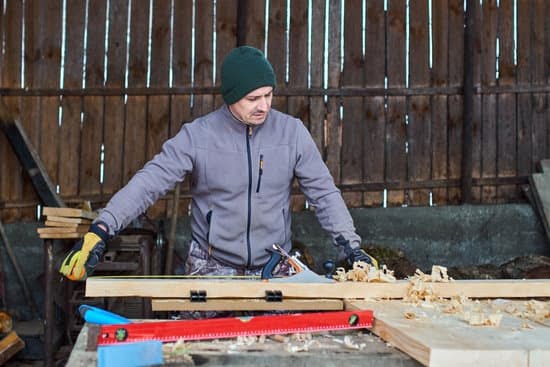Woodworkers rely on wood workbenches for a variety of reasons, from stability and durability to storage solutions and customization options. In this article, we will explore the many benefits of using a wood workbench in woodworking activities. From providing a solid foundation for woodworking to creating a secure working environment, wood workbenches play a crucial role in ensuring efficiency, comfort, and safety in the workshop.
One of the fundamental aspects of woodworking is having a reliable workbench. Wood workbenches not only provide a sturdy surface for working with materials but also offer ample storage for tools and supplies. Additionally, wood workbenches can be tailored to individual needs, making them an essential piece of equipment for any woodworker’s workshop.
Throughout this article, we will delve into the importance of stability, the durability and longevity of wood workbenches, and their ergonomic benefits. We will also compare wood workbenches to other types of workbenches to illustrate why they are often the preferred choice among woodworkers. Whether you are new to woodworking or looking to upgrade your workshop setup, understanding the basics of wood workbenches is essential.
The Importance of Stability
Wood workbenches play a crucial role in providing stability during woodworking activities. The sturdy and solid foundation that a wood workbench offers is essential for ensuring precise and accurate woodworking. This section will delve into the various aspects of stability that make wood workbenches indispensable for woodworkers.
Heavy-Duty Construction
One of the primary reasons why woodworkers use a wood workbench is its heavy-duty construction. Wood workbenches are typically made from robust and durable hardwoods such as maple, oak, or beech, which provide exceptional strength and stability. These workbenches are able to withstand the heavy loads, vibrations, and pressures associated with woodworking tasks, making them an ideal choice for those who require a reliable and stable surface to work on.
Secure Work Surface
Wood workbenches offer a secure work surface that is resistant to movement or shifting during woodworking activities. This stability is crucial for tasks such as sawing, planing, chiseling, or sanding, where precision and control are paramount. Woodworkers can rely on the solid foundation provided by a wood workbench to ensure that their projects are executed with accuracy and finesse.
Prevents Vibration
Another benefit of using a wood workbench is its ability to minimize vibration when working with power tools. The substantial weight and density of the wood help dampen vibrations caused by tools such as power drills or sanders, resulting in a smoother and more controlled woodworking experience. This contributes to improved accuracy and reduces the risk of accidents or errors caused by excessive tool vibration.
Storage Solutions
Wood workbenches are an essential component of any woodworking workshop, providing a sturdy and versatile surface for a variety of tasks. In addition to their work surface capabilities, wood workbenches also serve as an effective storage solution, keeping tools and materials organized and within easy reach. Here are some ways in which wood workbenches contribute to maintaining a clutter-free and efficient workspace:
- Drawers and Shelves: Many wood workbenches come equipped with built-in drawers and shelves, allowing woodworkers to neatly store hand tools, power tools, small parts, and other woodworking accessories. This not only keeps the workspace tidy but also ensures that necessary tools are readily accessible during the woodworking process.
- Pegboards and Tool Racks: Some wood workbenches feature pegboards or tool racks on the back or sides of the bench. These storage solutions provide convenient hanging space for saws, clamps, hammers, and other frequently used tools, maximizing organization and minimizing the risk of misplacing essential items.
- Under-Bench Storage: Many wood workbenches also offer storage space beneath the work surface. This area can be used to store larger items such as power tools, lumber, sandpaper, and finishing supplies. By utilizing this often-overlooked space, woodworkers can free up valuable floor space in their workshop while keeping supplies easily accessible.
By incorporating these storage solutions into their woodworking setup with a wood workbench, woodworkers can maintain a well-organized workspace that promotes efficiency and productivity.
In addition to providing a solid foundation for various woodworking tasks, one of the key reasons why woodworkers use a wood workbench is its ability to effectively keep tools and materials organized. With everything in its rightful place within arm’s reach, this type of workbench allows woodworkers to focus on honing their craft without the distraction of searching for misplaced items.
Ultimately, investing in a quality wood workbench can significantly streamline woodworking operations while promoting a more enjoyable working environment.
Durability and Longevity
Woodworkers use wood workbenches for several reasons, and one of the most important is their durability and longevity. A well-made wood workbench can last for decades, providing a stable and reliable surface for all manner of woodworking tasks. The strength of wood workbenches comes from the quality of the materials used, as well as the construction techniques employed to create a sturdy and robust work surface.
One of the key factors that contribute to the durability of wood workbenches is the type of wood used in their construction. Hardwoods such as maple, oak, or beech are commonly favored for their strength and resistance to wear and tear.
These woods are less likely to dent or scratch, ensuring that the workbench remains in good condition even after years of heavy use. Additionally, many woodworkers choose to treat their workbenches with finishes or coatings that further enhance their resilience against moisture, stains, and other potential sources of damage.
In addition to being durable, wood workbenches are also known for their longevity. Unlike some metal or composite work surfaces that may degrade over time due to rust or warping, properly maintained wood workbenches have the potential to remain in excellent condition for countless years. This makes them a sound investment for woodworkers who are looking for a reliable and long-lasting workspace.
| Durability Factors | Longevity Enhancements |
|---|---|
| Quality hardwood materials | Treatment with protective finishes/coatings |
| Resistance to dents and scratches | Proper maintenance routine |
Customization Options
Woodworkers use a wood workbench for its customization options, allowing them to tailor the workbench to fit their specific woodworking needs. From adding storage solutions to adjusting the height and size, wood workbenches offer endless possibilities for customization.
Adjustable Height and Size
One of the main reasons why woodworkers prefer using a wood workbench is the ability to adjust the height and size according to their individual requirements. This feature provides comfort and efficiency, as it allows the woodworker to work at a height that reduces strain on the back and arms. Additionally, having a workbench in the size that fits the available space in the workshop ensures optimal workflow.
Integrated Storage Solutions
Another appealing aspect of wood workbenches is their potential for integrated storage solutions. Woodworkers can add drawers, shelves, pegboards, and tool racks to keep tools and materials organized and within reach. This not only maximizes workspace but also contributes to a safer working environment by reducing clutter on the floor.
Accessory Options
Wood workbenches also offer various accessory options such as vises, clamps, bench dogs, and holdfasts that can be added or removed based on specific woodworking tasks. These accessories provide versatility and adaptability for different projects, making wood workbenches an essential piece of equipment in any woodworking shop.
Overall, the ability to customize a wood workbench makes it a valuable asset for woodworkers of all skill levels. Whether it’s adjusting height and size or adding storage solutions and accessories, a customized wood workbench enhances productivity and efficiency in woodworking activities.
Ergonomic Benefits
Woodworkers use wood workbenches for a variety of reasons, including the ergonomic benefits they provide. A key reason why woodworkers use a wood workbench is that it contributes to their comfort and efficiency while working on their projects. The design and construction of a wood workbench are specifically tailored to minimize strain or discomfort that can arise from long periods of woodworking.
One of the main ergonomic benefits of using a wood workbench is that it allows woodworkers to work at a comfortable height, reducing the risk of back or shoulder strain. Additionally, many wood workbenches are designed with features such as adjustable height settings or built-in vises, allowing for greater customization and adaptability to individual working preferences. This ability to personalize the workbench setup plays a significant role in improving overall comfort and increasing productivity during woodworking tasks.
Furthermore, wood workbenches are typically sturdy and stable, providing a reliable surface for woodworking activities. This stability not only enhances safety but also ensures that woodworkers can have better control over their tools and materials, ultimately leading to more precise and efficient work. For these reasons, it’s clear why woodworkers prefer using a wood workbench when engaging in their craft.
| Ergonomic Benefits | How Wood Workbenches Contribute to Comfort and Efficiency |
|---|---|
| Woodworkbench design minimizes strain and discomfort during long periods of woodworking | Allows for comfortable working height and reduces risk of back or shoulder strain |
| Features such as adjustable height settings enhance customization and adaptability | Promotes personalized setup for improved comfort and increased productivity |
| Sturdy construction provides stability for better control over tools and materials | Enhances safety and ensures precise and efficient woodworking tasks |
Safety Features
Wood workbenches play a crucial role in ensuring a safe working environment for woodworkers. The design and construction of wood workbenches incorporate various safety features that minimize the risk of accidents and injuries. Here are some key safety features that highlight the importance of using a wood workbench in woodworking activities:
- Sturdy Construction: Wood workbenches are built to withstand heavy loads and provide a stable platform for woodworking tasks. This stability reduces the likelihood of the workbench tipping over during use, thereby preventing accidents.
- Clamping Systems: Many wood workbenches come equipped with integrated clamping systems, such as bench vises, which securely hold the workpiece in place. This feature prevents slipping or movement of the material being worked on, reducing the risk of injuries from unexpected shifts.
- Smooth Edges and Surfaces: Wood workbenches are designed with smooth edges and surfaces to minimize the risk of cuts and scrapes during handling. These rounded edges and corners create a safer working environment for woodworkers.
In addition to these safety features, wood workbenches also offer customizable options for adding safety accessories such as tool holders, dust collection systems, and ergonomic design elements that contribute to creating a secure workspace.
Taking into account these safety features, it becomes evident why woodworkers use wood workbenches to ensure a secure working environment. The combination of sturdy construction, clamping systems, smooth surfaces, and customizable safety options make wood workbenches an essential tool for promoting safety in woodworking activities.
Comparing Wood Workbenches to Other Types of Workbenches
Wood workbenches have been a staple in woodworking shops for centuries, and for good reason. The use of wood as the primary material for workbenches offers a wide range of advantages that make it stand out among other types of workbenches. This section will delve into why wood reigns supreme when it comes to comparing workbenches.
One of the main reasons why woodworkers use a wood workbench is because of its unmatched stability. Wood is a strong and sturdy material that provides a solid foundation for woodworking activities. Unlike metal or plastic workbenches, wood workbenches are less prone to wobbling or shifting during use, ensuring precision and accuracy in woodworking tasks.
Another key factor that sets wood workbenches apart is their customization options. Wood can be easily tailored and modified to fit specific woodworking needs, whether it’s adding on tool racks, clamps, or vices. This level of flexibility allows woodworkers to create a personalized workspace that enhances efficiency and productivity.
Furthermore, durability and longevity are crucial considerations when choosing a workbench. Wood workbenches are known for their resilience and ability to withstand heavy-duty use over time. With proper maintenance, a well-built wood workbench can last for generations, making it a worthwhile investment for any woodworking enthusiast. These factors combined make it clear why woodworkbench is the top choice for serious woodworkers.
Conclusion
In conclusion, woodworkers use wood workbenches for a variety of reasons that contribute to the success and quality of their woodworking projects. The stability provided by a wood workbench offers a solid foundation for working with wood, ensuring precision and accuracy in all tasks. Additionally, the storage solutions available with a wood workbench help keep tools and materials organized, reducing clutter and increasing efficiency in the workspace.
Furthermore, the durability and longevity of wood workbenches make them an essential investment for woodworkers. Their ability to withstand heavy use over time ensures that they remain a reliable piece of equipment in any woodworking shop. Customization options also play a crucial role in why woodworkers choose wood workbenches, as they can tailor the bench to fit their specific needs and preferences, ultimately improving their overall workflow.
Ultimately, the ergonomic benefits, safety features, and overall superiority of wood workbenches when compared to other types of workbenches further demonstrate why they are favored by woodworkers. By providing comfort, security, and practicality in woodworking activities, it is clear why wood workbenches are an indispensable tool for professionals and hobbyists alike.
Frequently Asked Questions
What Is the Use of Woodworking Workbench?
The woodworking workbench is primarily used as a sturdy and level work surface for various tasks such as sawing, drilling, sanding, and assembling wood pieces. It provides stability and support for the woodworker to use various tools.
Why Is Wooden Top Used on a Workbench?
Wooden tops are commonly used on workbenches because they are durable, provide a firm grip, and can withstand heavy-duty tasks. Additionally, wooden tops are less likely to damage or scratch the materials being worked on compared to metal or other materials.
Why Do You Need a Workbench?
A workbench is essential for woodworkers as it provides a designated and organized space for working on projects. It offers stability, helps in keeping tools accessible and secure, and allows for accurate measurement and cutting of materials. In essence, a workbench acts as the central hub for woodworking activities in a workshop.

Hi everyone! I’m a woodworker and blogger, and this is my woodworking blog. In my blog, I share tips and tricks for woodworkers of all skill levels, as well as project ideas that you can try yourself.





